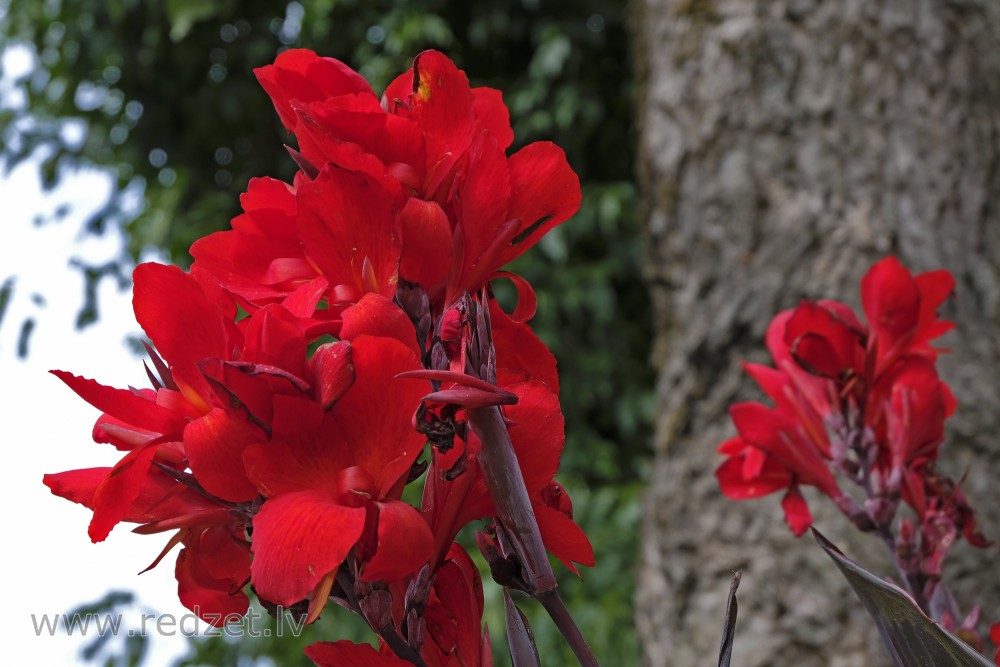(Canna indica) Indian shot
Canna indica, commonly known as Indian shot, African arrowroot, edible canna, purple arrowroot, Sierra Leone arrowroot,is a plant species in the family Cannaceae. It is native to much of South America, Central America, the West Indies, Mexico, and the southeastern United States (Florida, Texas, Louisiana, and South Carolina). It is also naturalized in much of Europe, sub-Saharan Africa, Southeast Asia, and Oceania.
Canna indica is a perennial growing to between 0.5 m and 2.5 m, depending on the variety. It is hardy to zone 10 and is frost tender. The flowers are hermaphrodite. Canna indica sps. can be used for the treatment of industrial waste waters through constructed wetlands. It is effective for the removal of high organic load, color and chlorinated organic compounds from paper mill wastewater.
Canna indica (achira in Latin America, cana-da-índia in Brazil) has been a minor food crop cultivated by indigenous peoples of the Americas for thousands of years.
Seeds
The seeds are small, globular, black pellets, hard and dense enough to sink in water.They resemble shotgun pellets giving rise to the plant's common name of Indian shot. The seeds are hard enough to shoot through wood and still survive and later germinate. According to the BBC "The story goes that during the Indian Mutiny of the 19th century, soldiers used the seeds of a Canna indica when they ran out of bullets."
The seeds are widely used for jewellery. The seeds are also used as the mobile elements of the kayamb, a musical instrument from Réunion, as well as the hosho, a gourd rattle from Zimbabwe, where the seeds are known as "hota" seeds.
As food
The C. indica (achira) rhizomes are large, up to 60 centimetres (24 in) in length, and edible. They can be eaten raw, but are usually baked. Cooked, the rhizomes become translucent, mucilaginous, and sweet. Starch is produced by grinding or pounding the roots and soaking them in water, separating the starch granules from fibers in the roots. The starch granules of C. indica are also translucent and the largest known from any plant. The starch is occasionally marketed commercially as "arrowroot", a name also applied to the starch of other similar roots crops such as Maranta arundinacea. It was an ingredient in mid-nineteenth century recipes such as cakes and was called tout-les-mois.
The Spanish took notice of achira in 1549 when it was mentioned as one of four root crops being grown for food by the people of the Chuquimayo valley (Jaén province) of Peru. The other three were sweet potato (Ipomoea batatas), cassava (Manihot esculenta), and racacha (Arracacia xanthorrhiza). In 1609, achira was described by a Spanish visitor to Cusco, Peru. In modern times, achira is rarely grown for food, although in the 1960s it was still an important crop in Paruro Province on the upper Apurimac River near Cusco. There, at elevations of up to 2,600 metres (8,500 ft), achira is cultivated and harvested, especially to be eaten during the Festival of Corpus Christi in May or June. The achira rhizomes are wrapped with achira leaves and placed in a pit with heated rocks. The pit is then filled with dirt and the achira is slowly baked underground.
en.wikipedia.org
https://en.wikipedia.org/wiki/Canna_indica
Continue reading


